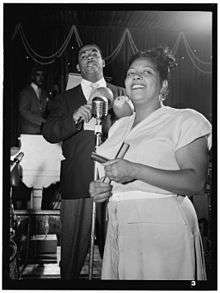Graciela
Graciela (August 23, 1915 – April 7, 2010)[1] was an Afro-Cuban singer of Latin jazz.[2]
Graciela | |
|---|---|
 Machito and Graciela singing | |
| Background information | |
| Birth name | Graciela Pérez Gutiérrez |
| Born | August 23, 1915 Jesús María, Havana, Cuba |
| Died | April 7, 2010 (aged 94) New York City |
| Genres | Latin Jazz |
| Occupation(s) | Singer |
| Years active | 1934–2010 |
Biography
Felipa Graciela Pérez y Gutiérrez was born in Havana, Cuba and raised in the Afro-Cuban Jesús María neighborhood.[3] A pioneer in music, as a black Cuban woman, in a so-called man's world, she opened doors for all those who followed her. She performed around the world, recording and sharing the stage with her adoptive older brother, Frank "Machito" Grillo, who encouraged her to sing. They played alongside Mario Bauzá (originator of the genre of Afro-Cuban Jazz) in the world-renowned orchestra Machito and the Afro-Cubans. Graciela was primarily known for her tremendous voice, risque and sassy stage presence and sexy double entendre lyrics. She could sing a jazzy guaracha as easily as handling the most romantic boleros. Though her last names were Pérez Gutiérrez, she was only known by her first name, "Graciela", long before doing so became widely fashionable among musicians.
She was summoned to New York City in 1943 by Mario Bauzá, when Machito was drafted into the army. She joined the orchestra as lead singer until Machito returned in 1944 and from then on the three shared the stage together until their untimely split in 1975. For thirty-two years they were on top of the charts and were the orchestra not only to beat, but to emulate. Not only did they travel the United States and the rest of the world, but they were leaders and reigned supreme during the heyday of the Palladium Ballroom (where blacks, Jews, Italians and Hispanics, and celebrities would converge to dance), from 1946 until its closing in 1966. Besides the Palladium, they would perform at the Royal Roost, Birdland, the Park Palace, the Corso and the Apollo Theater on a yearly week-long gig—and many other clubs and theaters in New York. Graciela and the orchestra also performed on a yearly basis in Hollywood—specifically at the Crescendo nightclub. Graciela and the band were also a favorite of the famous deejay Symphony Sid Torin who had them on his weekly program several times a year, and was broadcast coast to coast in the 1940s and '50s. They were also the summer headliners in the Concord Resort Hotel, in the Catskills Mountains, for more than twenty years.
They recorded albums in which her best-known recordings include "Esta es Graciela", "Íntimo y Sentimental" and "Esa Soy Yo, Yo Soy Así".[4]
Death
Felipa Graciela Pérez y Gutiérrez died at the age of 94 at New York Cornell-Presbyterian Hospital in New York City at 7:58 am, Wednesday, April 7, 2010. She had renal and pulmonary failure.[1] She was cremated as per her wishes.
Discography
- 1952 - Arthur Murray mambo - ¿Dónde estabas tú? - Graciela con Machito y su Orquesta Afro-Cubana
- 1963 - Esta es Graciela - Graciela con Machito y su Orquesta
- 1965 - Íntimo y sentimental - Graciela con Machito y su Orquesta
- 1972 - Yo soy así
- 1999 - Sí sí no no - Graciela y Mike Young
- 2000 - Cubop City - Graciela con Machito and his Afro-Cubans, Howard McGhee, Brew Moore, Flip Phillips
- 2004 - Inolvidable - Candido & Graciela
References
- Thedeadrockstarsclub.com Accessed April 2010
- Los Angeles Times obituary, April 13, 2010; page AA7
- Obituary in The Independent Online
- Biodata